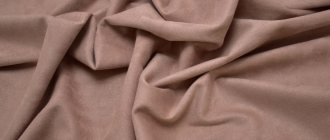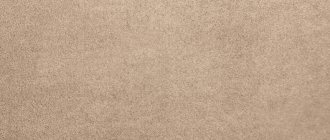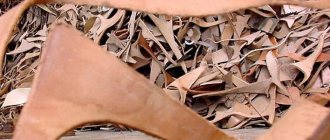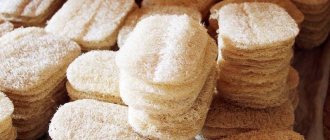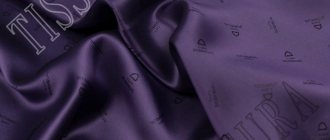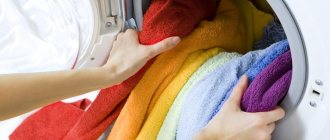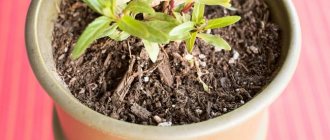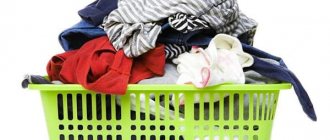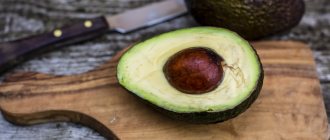Qualities of natural suede
Natural suede is leather tanned in a special way. It is made mainly from the skins of large wild horned animals. After obtaining the raw materials, an expensive manufacturing process follows. Therefore, genuine suede has a high price. However, you can also put a high price on a fake; do not be guided only by this indicator.
On a note! An artificial substitute can also have a high price; this indicator is not reliable.
Natural suede has the following qualities:
- thin, but very durable;
- “breathes” well;
- the material is soft and porous;
- does not have a reverse side - the same appearance on both sides.
It feels very durable and somewhat similar to rubber, as it is very elastic, but does not have much stretch.
How to spot a fake
There are a number of qualities that are characteristic of real suede. These are the ones you should focus on when purchasing.
- Porous structure. Small cracks and scratches are easily visible on it, because it is made of animal skins. The fabric of artificial material is uniform in structure and perfectly smooth. It is difficult to find even minor imperfections in it.
- If you run your finger across the surface of expensive suede boots, you will leave a mark that is different in color from the area that was not touched. Streaks do not remain on artificial material.
- The natural material is velvety and soft, but not rough.
- High-quality shoes smell like leather, but substitutes have a synthetic aroma.
- If the back of the product is made of fabric, it is an ordinary fake.
- Natural suede costs more, but you shouldn’t focus only on cost. Unscrupulous sellers use various tricks to sell low-quality products at inflated prices.
- Water will help you distinguish a cheap analogue: real leather quickly absorbs moisture, after which wet spots will remain on its surface.
Having tested your favorite pair of suede shoes on the listed points, there should be no doubt as to whether they are made of genuine leather or artificial leather.
Characteristics of artificial suede
Artificial material varies in quality. The price and performance characteristics depend on this. Suede substitute is made in two ways:
- woven;
- non-woven.
The first method involves splitting the base into small fibers.
Thus, they are tightly located and firmly “sit” on the base. The second method involves gluing small fibers onto the base. The quality of products made in this way may also vary. Budget options may have bald patches or glued fibers. Higher quality options will not have such shortcomings, however, this method is still worse than the first. Material made in this way is less durable and strong.
In general, artificial material is characterized by the following characteristics:
- There is a reverse side. Since faux suede is based on textiles, the fibers are only on one side. The reverse side has a different structure.
- Non-natural material is less elastic, it bends poorly and does not stretch at all.
- Poor breathability. As a result of the fact that the fabric base is impregnated with special waterproof agents, it does not allow air to pass through well.
Also one of the characteristics is ease of maintenance. The substitute is not afraid of too high or low temperatures and moisture. While natural suede needs to be dried under the right conditions.
On a note! For a substitute, it is not necessary to meet special humidity and temperature conditions during drying, but it is better to provide them to increase the service life of the product.
Description of natural material
Suede fabric on a natural basis is obtained by tanning and impregnating the skin of deer, goats, sheep or calves with a special fat composition. The result is a beautiful product, which is an elastic, thin material with a delicate and fleecy surface.
There are two grades of this material, differing in quality and appearance depending on the type of leather used in their production. If calf or sheep skins are used to produce suede, it turns out, on the one hand, denser, and on the other, very thin and delicate, so it is easily damaged.
Natural fabric of another type is made by processing the skin of deer, chamois, elk, and mountain goats. It is particularly soft, highly stretchable and breathable. This suede is ideal for sewing outerwear, accessories and shoes. When making these things, dulbfas is often used - a double-sided material that does not have a backside, decorated on both sides beautifully and carefully.
To obtain suede fabric, animal skins are tanned with a variety of animal and vegetable fats. The prepared layers of leather are lubricated with a greasy mixture and placed in a special machine under a press, where it is gradually soaked. This process is quite labor-intensive and can take from 3 to 5 days. After a certain time, the fat tightly combines with the skin composition, and the material acquires a homogeneous structure. After this, the fabric is dyed.
Real suede has a matte and velvety surface, it is very durable, waterproof and breathable. This distinguishes it from artificial materials and natural velor - a similar fabric that has a lower cost and does not have the same plasticity, waterproofness and strength.
Gallery: natural suede (25 photos)
Properties of real suede
Products made from this type of leather have always been very popular among consumers. But thanks to the advent of modern technologies in the textile industry, the production of artificial materials has reached such a high level that it has become almost impossible to distinguish them from natural ones. To correctly determine the quality of suede, you need to pay attention to the following aspects:
- Real material will always emit a subtle aroma of leather, which cannot be faked. Man-made products have a strong synthetic smell or may not smell at all.
- The structure of natural suede cannot be ideal - you can always notice pores and small abrasions on the surface of the fabric. The fake will always be perfectly smooth without the slightest flaw. To check the quality of the material, you need to run your hand over it. The natural product has a very pleasant, soft and rough, movable surface. Faux suede is smoother and relatively hard to the touch.
- You definitely need to pay attention to the cost of the product. Real fabric has a fairly high price and will cost much more than fakes. But artificial material of very high quality is often found, almost in no way inferior to natural material, so things made from it can be sold at the same price. In this case, run your hand over the surface of the fabric to find out how to identify natural suede. It will be distinguished from an artificial one by the presence of a slight trace of a different shade after the touch of the fingers.
Basic rules on how to distinguish natural material from artificial
To check the naturalness of the material, you can conduct several tests. They are quite simple and can be made right at the point of purchase.
- Take the product in your hands. Whether it's shoes or other products, touch the surface with your palm. The natural base is cold, but it will quickly warm up from the warmth of your hand, the artificial one will be warm initially and will not change the temperature.
- Press your fingers into the surface. On a substitute, fingerprints are more visible and will remain for a longer time.
- Apply a small drop of water. A natural base will quickly absorb moisture; with an artificial one, it will simply slide off.
On a note! The best way to determine naturalness is by touch.
To the touch, natural suede is elastic, cold, soft, somewhat reminiscent of rubberized leather, the pile is very short, so the surface is almost smooth.
DIY autumn dress
How to clean white suede
Production technology
The process of sueding natural leather using tanning substances helps give suede strength, ductility, softness and velvety. The production of suede fabrics is divided into several stages:
- Preparing skins with pre-haired skins.
- Skinning is the removal of the dense top layer.
- Treating the hide with formaldehyde.
- Applying seal, cod, whale oil or a vegetable mixture to the cleaned skin.
- Placing the fabric in special impact grinders, where the fat is absorbed into the fibers.
- The skins are folded and heated.
- The fatliquoring procedure is repeated, if necessary, several times.
- Degreasing the canvas in a potash solution.
- If necessary, the material is treated with abrasive for greater hairiness.
- The canvas is painted. Since it is initially brown in color.
Kinds
In the range of textile products you can find several types of natural suede. Each of them has its own characteristics and properties.
By thickness
There are 2 types of material:
- Refined grade - has excellent breathability. Made from goat or deer skins.
- Unrefined variety - the fabric is denser and less elastic. Made from sheep and calf skins.
Double face double sided
The name “double face” means that the fabric has two front sides. Typically, such suede material has a velvety front and a fur base on the back. Double front suede is usually used for sewing warm outerwear and non-rough shoes.
Scuba
Suede on a scuba is a material consisting of 2 layers: artificial suede and knitted fabric. The fabric is more durable than natural suede, stretches well, is less sensitive to external influences and costs less. The material is easy to care for and can be used for sewing clothes and shoes.
Coasting
Natural suede treated with laser coating. This treatment reduces the traumatic nature of the material and the possibility of surface abrasion. Products made from rolled suede look more impressive due to their characteristic shine.
Synthetic
Made from synthetic polyester or microfiber fibers. Externally, synthetic suede is practically no different from natural one, but has additional advantages in the form of resistance to dirt and deformation.
Reinforced
Special suede cleaning wipes eliminate the use of household chemicals. The fabric consists of polyester fibers. It has a velvety surface that helps clean surfaces without streaks and additional effort.
Furniture
A dense synthetic material consisting of 100% polyester, which is used for upholstery. Outwardly, it strongly resembles suede, but is more resistant to mechanical stress, denser and more wear-resistant.
Pros and cons of natural suede
Like any other material, suede has advantages and disadvantages.
Advantages of natural suede:
- Aesthetic appearance. Suede items look chic, but at the same time neat and noble.
- Long service life. If you properly care for the material, it will remain in its original form for a long time. Even abrasions and small defects will not spoil the quality of the canvas.
- Thermal insulation properties. The fabric retains heat well in winter and cool in summer, so it is indispensable in the production of clothing and footwear.
- Comfort. Suede clothes are very comfortable. The material does not restrict movement, is very pleasant to the body and allows the skin to breathe.
- Compliance. The elastic properties of suede help fabrics stretch and quickly restore their original shape.
- Antistatic and hypoallergenic. Due to its natural nature, suede does not accumulate static electricity and does not cause allergic reactions.
Despite the many advantages, the material also has disadvantages:
- Absorbs moisture. This affects the comfortable wearing of clothes and shoes and their aesthetic appearance, since the material, together with moisture, attracts dirt and takes a long time to dry.
- Instability to mechanical stress. The material is quite easy to tear.
- Difficulty of care. Suede items require delicate handling, dry cleaning and additional procedures to preserve their appearance.
- High price. Compared to artificial analogues, natural suede is more expensive.
Sometimes suede manufacturers coat their fabrics with special compounds to reduce the risk of damage.
Differences between natural suede and synthetics
The natural product is soft like fabric and retains this property even after repeated washing with soap. The pile is very delicate and almost invisible.
Unlike its substitute, natural suede is famous for its numerous distinctive properties:
- allows air to pass through;
- with proper care, it retains its presentability and functional qualities for many years;
- absorbs a small amount of water, allowing the inside of the products to remain dry;
- retains heat perfectly.
Some characterizing qualities of high-quality material can be called disadvantages:
- requires careful care;
- absorbs dust and dirt;
- With everyday use, it quickly loses its aesthetics.
Reference! People call suede material “washable leather.”
Useful tips for choosing suede
Suede is a high-quality, but whimsical and expensive material. Therefore, you need to think a hundred times before purchasing something made from genuine leather. If you are purchasing suede for the first time, it is recommended to give preference to artificial material. It won't be such a shame if you can't properly care for the product.
There are some more useful tips for choosing suede:
- When purchasing a product, you need to pay attention to the lining . It must be movable, which will prevent deformation of the material.
- The natural product stretches well. Therefore, it is not recommended to buy things, especially shoes, clothes “to grow.”
- It is difficult to find suitable clothes for suede, so before buying you should think about whether there are suitable things in your wardrobe . Otherwise, expensive clothes will hang uselessly in the closet.
- The first “suede” purchase should be an accessory: handbag, gloves, strap, wallet. This will help you get used to the material and find out if it is right for you.
Attention! When purchasing, you need to pay attention to how the products are stored. There must be a special filler inside the shoe to prevent deformation. Clothes should hang on hangers.
If a person prefers to wear clothes made of suede, this speaks of his impeccable taste. Well-groomed, clean things bring joy to the owner for many years and allow him to stay warm in cold weather and increase his status in the eyes of those around him. What to choose, a natural product or synthetics, is a personal decision of each person, in which material capabilities play a large role.
Rules of care
Suede is a natural material that requires careful care. Shoes, clothes, gloves are made from it, and each type of product has its own care rules. How suede looks depends on proper care.
Suede gloves
Shoes
Suede - what kind of shoe material is it? For shoes, three types of rough suede are usually used - thin, medium and thick. The top (for example, the boot) is sewn from thin and medium, and the bottom from thick.
Shoe upper
Shoes are susceptible to contamination (open pores actively absorb dirt). Moisture causes “gluing” of the villi. For this reason, it should not be worn in the rain, through mud or washed. If it gets wet, you just need to dry it, clean it and comb the pile with special brushes.
You might be interested in what is PVC coated awning fabric
Important! Shoes should be dried flat (stuffed with paper), cleaned only when dry. Dust and dirt (dried) are removed with special brushes
To remove grease stains, you can use special products or pure gasoline without impurities, for example, for lighters
Dust and dirt (dried) are removed with special brushes. To remove grease stains, you can use special products or pure gasoline without impurities, for example, for lighters.
Note! You cannot use creams or wax to care for your shoes, as this can completely ruin the material.
Outerwear
Caring for outerwear is no different from shoes. Suede quickly becomes dirty, greasy and prone to oil stains; it is not suitable for traveling on public transport. Must be protected from moisture. Under the influence of water, the skin can become deformed and lose its velvety quality.
Note! The material actively absorbs moisture thanks to its pores, swells and does not allow water to pass through. Gets hard when dry
For cleaning you need to use branded products. Cleaning greasy areas is possible with the application of gasoline
Then this place needs to be carefully wiped with a sponge. Care rules:
- vacuum constantly;
- brush regularly;
- try not to soak in water;
- wash, hanging on hangers, with special brushes and dry only in a straightened form;
- do not soak;
- Do not dry in front of heating appliances.
Suede jacket
How to care for gloves
The gloves are made from the thinnest and softest suede; they must be worn carefully, do not soak them, and when drying, fill them with paper. In addition, you should comb with a brush to maintain the pile, otherwise “bald” areas may appear. You can get rid of greasy stains with pure gasoline; it is more convenient to put a glove on your hand. You can also clean it with synthetic products.
Which shoes are better: suede or leather?
Before you decide which shoes to buy: suede or leather, decide on the conditions under which they will be used. For example:
- if you need the warmest boots possible, give preference to suede;
- if you plan to wear boots in wet weather, choose leather products;
- Patent leather can crack in the cold.
In any case, before purchasing, carefully inspect the shoes for quality and naturalness, try them on and determine which shoes you feel most comfortable in. If you use dirt-repellent products and carefully care for the products, you can buy both suede and leather shoes.
Suede is an elegant and aesthetic material. The fabric is quite durable and elastic, breathable and at the same time warm, very pleasant to the body and does not cause skin reactions. The disadvantages usually include the ability to absorb moisture and instability to mechanical stress, which can be avoided with careful use and delicate care.
What does a shoebox say?
It also has a lot of information. Here on the shoes
the name, country of origin, name of the manufacturer, color, characteristics of the materials of the upper, lining and sole, size, fullness, model number (article), there may be other data (date of issue, certification, etc.) are indicated. The shoes are neatly wrapped inside , lined with paper, added moisture-absorbing bags, shoe horns, information on caring for this type of footwear.
This also characterizes the manufacturer on the good side. Considering all the information in the legend
, you will definitely make the right choice. Look at
